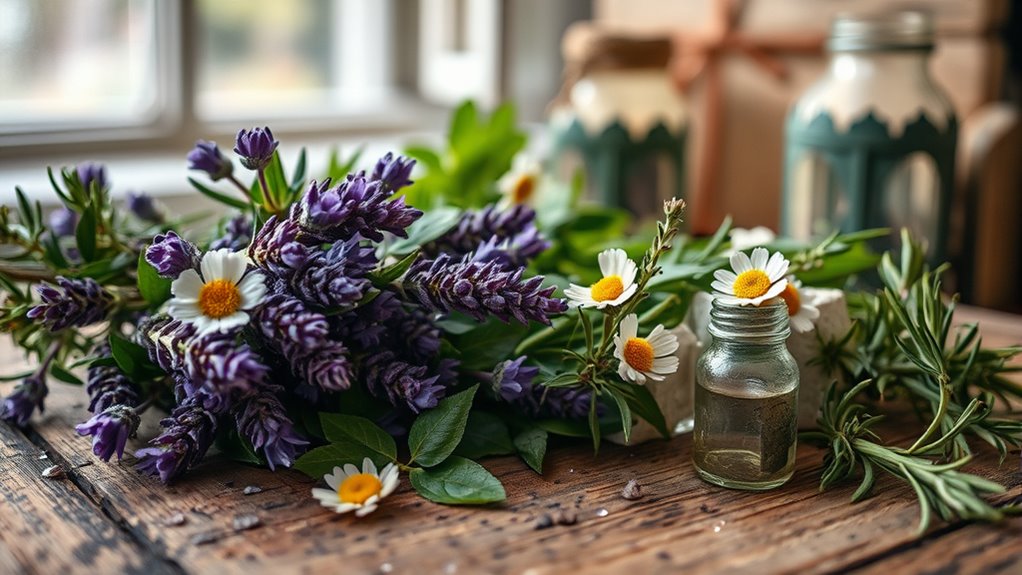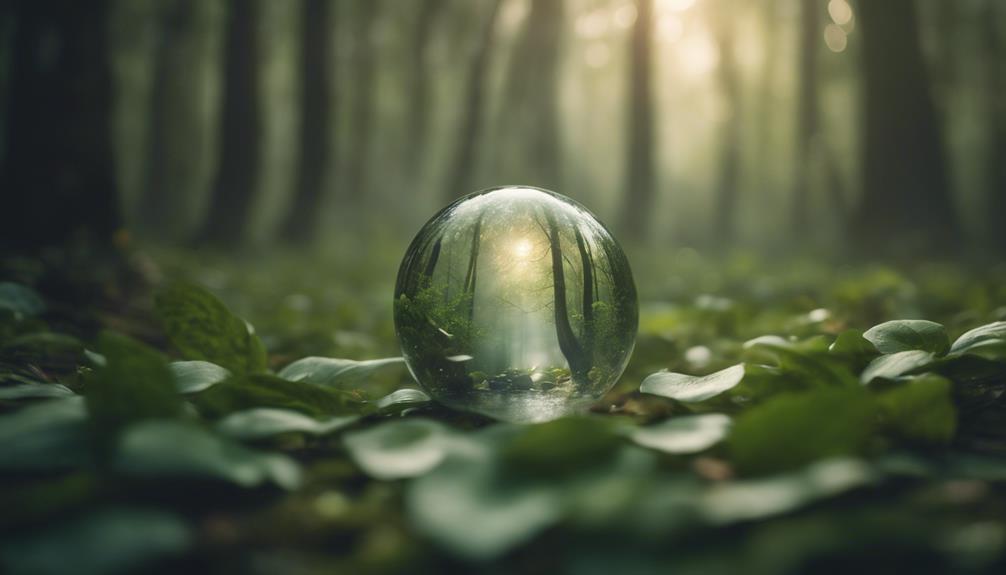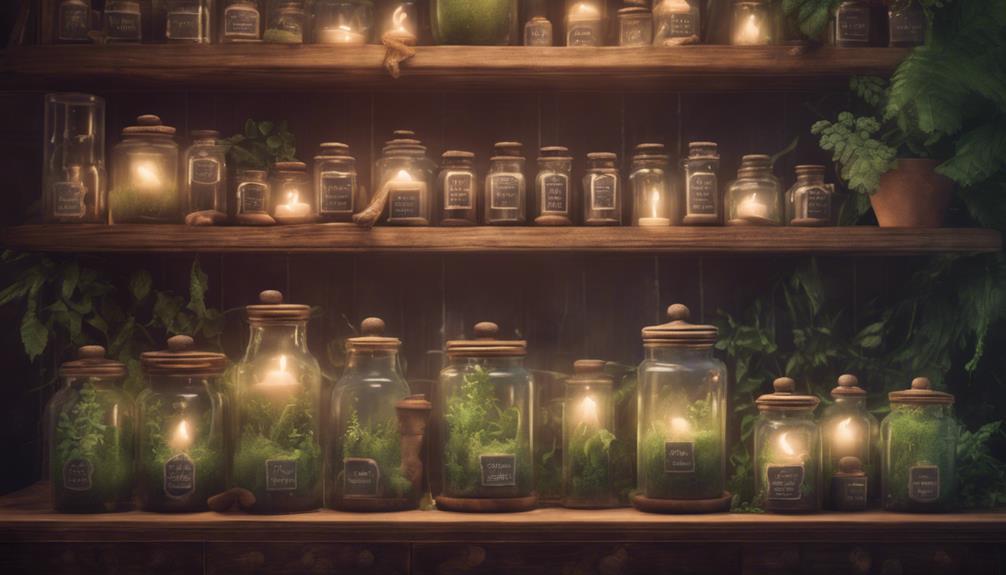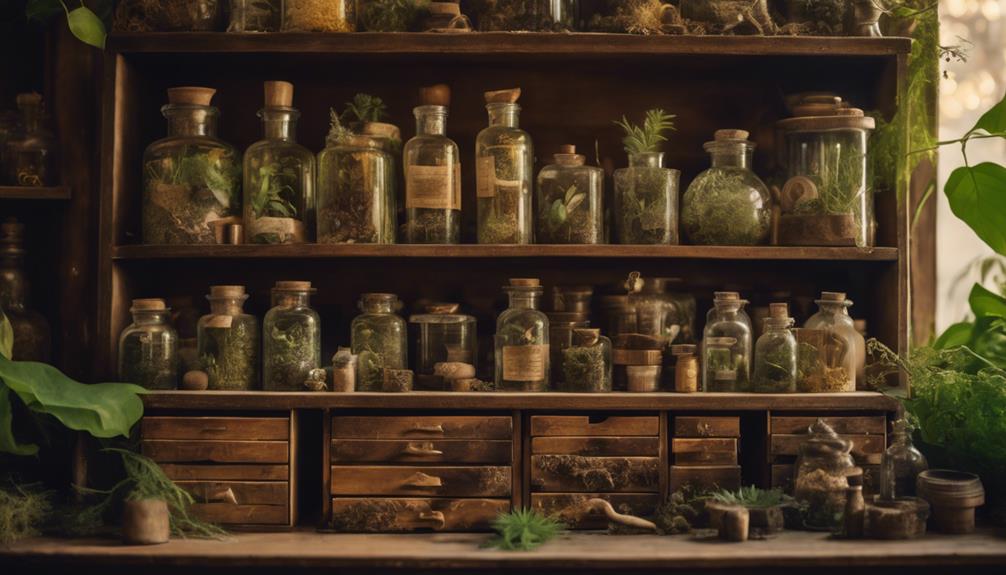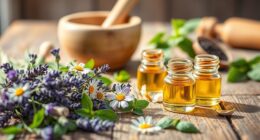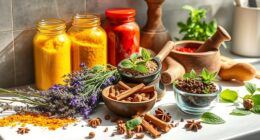Herbs in European witchcraft combine practical healing with mystical symbolism, shaping beliefs for centuries. Plants like mugwort, yarrow, and mandrake were believed to offer protection, cure ailments, and access hidden knowledge. While some claims are rooted in folklore and legend, scientific studies support certain properties, blurring fact and fiction. Exploring how these herbs were used in rituals and magic reveals a rich tradition that’s still influential today; discover more about their enduring significance.
Key Takeaways
- Many herbs used in European witchcraft have documented medicinal properties supported by modern science.
- Folklore and legends attribute mystical powers to herbs, blending fact with fiction.
- Herbs like mugwort and yarrow historically served both healing and protective magical purposes.
- Scientific evidence confirms some herbal effects, but myths often exaggerate or misinterpret their spiritual significance.
- Cultural traditions shape herbal uses, creating a mix of factual healing practices and symbolic, fictional beliefs.
The Role of Herbs in Medieval and Renaissance Witchcraft

During medieval and Renaissance times, herbs played a central role in witchcraft practices, serving both practical and mystical purposes. You relied on herbs not only for healing but also for their magical properties, blending traditional knowledge with spiritual beliefs. Modern herbal medicine traces its roots to these ancient practices, emphasizing the healing power of plants. At the same time, botanical taxonomy helped categorize and identify herbs accurately, ensuring that witches and healers used the right plants for specific purposes. This scientific approach improved the reliability of herbal remedies, bridging practical medicine and mystical traditions. By understanding the classification and properties of herbs, practitioners enhanced their craft, blending empirical knowledge with spiritual ritual in their healing practices.
Mugwort: The Witch’s Herb and Its Mystical Uses

Mugwort has long been cherished as a potent herb in European witchcraft, prized for its mystical and protective qualities. You might use it in medicinal preparations to ward off negative energies or to enhance intuition. Its magical symbolism is rooted in protection and dream magic, making it a staple in charms and amulets. Witches often burn mugwort to cleanse spaces or carry sprigs to guard against evil spirits. You can brew it into teas or infuse oils for spiritual clarity and protection. Its association with the subconscious made it popular for divination practices, helping you access hidden knowledge. Mugwort’s versatility in both healing and mystical rituals underscores its importance in traditional witchcraft, blending practical uses with symbolic power. Additionally, the development of candles with symbolic herbs in ritual practices can amplify these protective effects. Incorporating mugwort into ritual tools further enhances its effectiveness in spiritual work.
Yarrow: A Symbol of Healing and Protection

Yarrow has long been valued for its healing properties and its role in protecting those who use it. Throughout history, legends highlight its significance in rituals that promote safety and well-being. Exploring yarrow’s uses reveals its deep roots in European witchcraft and its enduring symbolism of health and protection. Modern herbal traditions often emphasize herbal protection as an integral part of spiritual and physical healing rituals. Additionally, scientific studies support its antimicrobial properties, which contribute to its reputation as a healing herb. Recognizing how traditional practices incorporate ritualistic use of herbs like yarrow enhances our understanding of their cultural significance. In modern times, its protective qualities are sometimes reflected in the use of herbal remedies like pimple patches, which serve as a targeted treatment to promote skin healing and safeguard against blemishes.
Yarrow’s Healing Properties
Yarrow has long been cherished in European witchcraft for its powerful healing and protective qualities. Its medicinal preparations have been used to stop bleeding, soothe wounds, and reduce inflammation. The herb’s herbal symbolism emphasizes health, resilience, and protection, making it an indispensable component in traditional healing practices. When you incorporate yarrow into your remedies, you tap into its natural ability to promote recovery and safeguard against harm. It was often used in poultices and infusions, highlighting its versatility in healing rituals. Yarrow’s reputation as a healing herb stems from its longstanding reputation in folklore and herbal medicine, proving its enduring value. Its significance in herbal symbolism underscores its role as a symbol of health and protection in European witchcraft traditions. Additionally, modern research supports its medicinal properties, confirming its continued relevance in herbal healing.
Protective Uses in Rituals
Because of its strong association with protection, yarrow has been a key ingredient in many European witchcraft rituals aimed at warding off harm. You might prepare yarrow for these rituals using herbal preparation techniques like crushing fresh leaves or drying them for amulets. Incorporating yarrow into charm bags or sprinkling it around your space enhances its safeguarding energy. In modern times, contemporary herbal activism emphasizes sustainable harvesting and respecting traditional uses, ensuring yarrow remains an essential part of herbal traditions. When used in rituals, yarrow’s presence acts as a shield, guarding against negative influences and promoting safety. Its symbolic power continues to resonate in contemporary practice, blending ancient symbolism with current herbal advocacy for preserving herbal knowledge. Additionally, cultivating a mindful attention to the plant’s creative practice can deepen your connection to its protective qualities. Recognizing the importance of traditional uses helps preserve the cultural significance of yarrow in modern herbalism. Understanding the herbal preparation techniques involved also enhances the efficacy and respect for this sacred plant. Engaging in mindfulness practices while working with yarrow can further strengthen its protective effects and foster a deeper spiritual connection. Exploring the plant’s phytochemicals can also provide insight into its enduring significance in herbal traditions.
Historical Significance and Legends
Throughout history, this resilient herb has been cherished for its powerful symbolism of healing and protection. Yarrow’s reputation in medieval medicine highlights its importance in herbal remedies used by healers and witches alike. Legends tell of its use in protecting warriors in battle, believed to stop bleeding and ward off evil spirits. During the herbal trade, yarrow was highly valued, making its way across Europe as a key ingredient in healing potions. Its enduring symbolism reflects its role in folklore and traditional practices. You’ll find that yarrow’s reputation persisted through centuries, inspiring stories of miraculous healing and divine protection. This herb’s historical significance lies not just in its medicinal use but also in the legends that elevated it to a sacred status among ancient communities. Herbal remedy practices further contributed to its revered status, emphasizing its role in holistic healing traditions. Additionally, its widespread use in **medieval medicine** underscores its importance as a fundamental herbal remedy throughout history. The symbolism of yarrow also extended to its use in various protective rituals, enhancing its mystical reputation among different cultures.
Mandrake Root: The Enigmatic Plant of Folklore
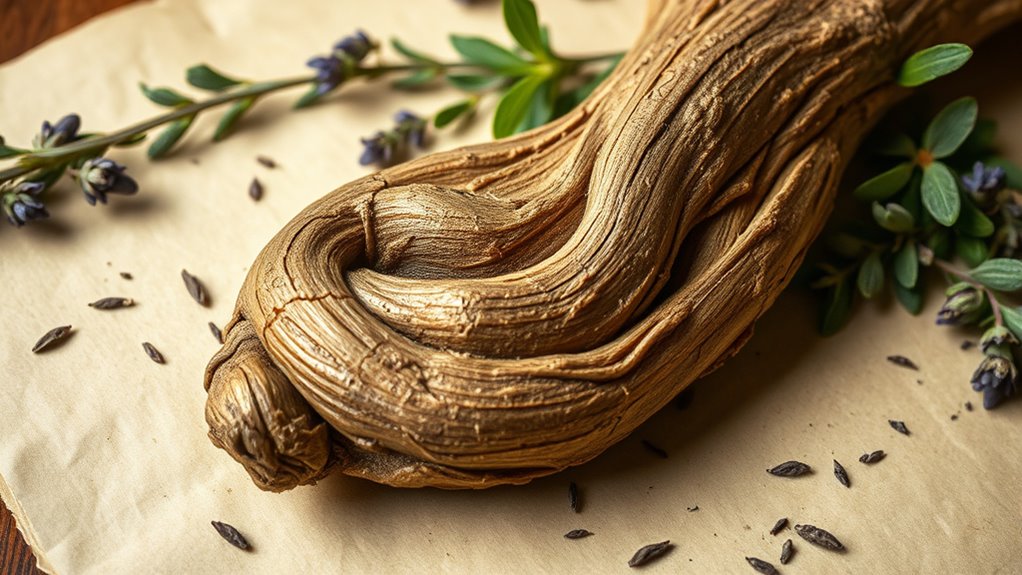
Have you ever wondered why the mandrake root has captivated European folklore for centuries? Its mythological reputation stems from mandrake mythology, where the plant’s human-like shape fueled legends of powerful, magical properties. Folklore symbolism often links the root to protection and potency, making it a prized talisman in witchcraft. People believed that pulling the mandrake could cause it to scream, bringing disaster or death, which added to its mystique. Its strange appearance and associations with death and healing made it a symbol of both danger and power. Interestingly, the root’s infused butter was sometimes used in traditional rituals, believed to enhance its mystical properties despite lacking scientific backing. The root’s folklore continues to inspire stories about its enchanted qualities, blurring the line between fact and fiction in the rich tapestry of European witchcraft traditions. Additionally, the cultural significance of mandrake roots reflects the deep-rooted fears and hopes associated with herbal magic throughout history. Moreover, the botanical features of the mandrake, such as its distinctive shape and size, contributed to its legendary status and symbolic meaning. Recognizing the importance of biodiversity in herbal traditions can deepen our understanding of how plants like mandrake influenced cultural beliefs and practices.
Herbs as Talismans and Protective Symbols

Herbs have long served as powerful talismans and symbols of protection in European witchcraft. You might carry or hang herbs like garlic or rosemary to ward off evil spirits or negative energy. Many herbs are believed to possess medicinal properties that enhance their protective power, while their culinary uses reinforce their significance in daily life. You can inscribe charms on herbs or burn dried leaves as a form of spiritual protection. Some common protective herbs include:
- Mugwort, used for psychic protection and warding off nightmares
- Basil, believed to attract good luck and repel harm
- Sage, burned to purify spaces and dispel evil
- Juniper, associated with guarding homes and preventing negative influences
These herbs serve both as talismans and as ingredients in rituals, blending their practical uses with symbolic meaning. Additionally, understanding the home decor can help create a peaceful environment that aligns with protective and calming practices in spiritual rituals. Incorporating cultural symbolism enhances their effectiveness in spiritual practices and personal belief systems.
The Scientific Perspective on Traditional Healing Plants

You might find that many herbs contain active compounds that can affect your body in measurable ways. Scientific studies often support some traditional claims, but they also reveal limitations and inconsistencies. Understanding both the evidence and the gaps helps you evaluate the true healing potential of these plants.
Active Compounds in Herbs
Many plants traditionally used in European witchcraft contain active compounds that produce measurable physiological effects. These compounds, found through herbal cultivation and botanical classifications, explain some of the healing claims. For example, alkaloids in certain herbs can affect your nervous system, while flavonoids offer antioxidant properties. You might find that essential oils contain volatile compounds that influence mood or reduce inflammation. Additionally, some plants produce tannins that have antimicrobial effects, and saponins can help in respiratory health. Understanding these active compounds helps clarify how these herbs work on a biochemical level, bridging traditional uses with scientific insights. Recognizing the specific chemical components allows you to better appreciate the plants’ potential benefits and their roles within herbal traditions.
Scientific Evidence for Efficacy
While traditional claims about healing herbs are widespread, scientific studies are essential to verify their actual efficacy. Researchers examine herbal toxicity to ensure these plants are safe for use, especially when consumed or applied medicinally. Using plant taxonomy helps scientists accurately identify herbs, preventing misidentification that could lead to harmful effects. Modern research investigates active compounds within herbs to determine their true therapeutic potential. Though some herbs show promising results, others may pose risks due to toxicity or unpredictable reactions. Scientific evidence often confirms or challenges traditional uses, emphasizing the need for rigorous testing. By combining traditional knowledge with scientific validation, you can better understand which herbs genuinely aid health and which require caution.
Limitations of Traditional Use
Traditional use of healing herbs often relies on anecdotal evidence and cultural practices, but scientific research reveals several limitations to this approach. Relying solely on traditional knowledge can lead to inconsistent results and overlooked side effects. Modern herbal marketing may exaggerate benefits without sufficient proof, making it essential to scrutinize claims carefully. Additionally, herbal supplement safety isn’t always guaranteed, especially when herbs are contaminated or improperly dosed. Scientific studies highlight the importance of rigorous testing to verify efficacy and safety. Without this, you risk using products that may be ineffective or harmful. Recognizing these limitations helps you make informed decisions and understand that traditional use, while valuable, should be complemented by scientific validation for better health outcomes.
Myths and Misconceptions Surrounding Witchcraft Herbs

Despite popular beliefs, the use of herbs in European witchcraft is often misunderstood. Many think witches solely relied on magical properties, but herbal pharmacology reveals a scientific basis for plant effects. Misconceptions also cloud witchcraft symbolism—herbs weren’t just mystical; they represented broader cultural meanings. To visualize, consider this table:
| Herb | Common Symbolism |
|---|---|
| Mugwort | Dream enhancement |
| Belladonna | Danger and protection |
| Lavender | Peace and healing |
| Sage | Wisdom and purification |
You might imagine herbs as both tools and symbols, blending herbal pharmacology with witchcraft symbolism. This duality helped witches understand plants’ real effects while imbuing them with spiritual significance—far from mere superstition.
Rituals and Spells Involving Healing Plants
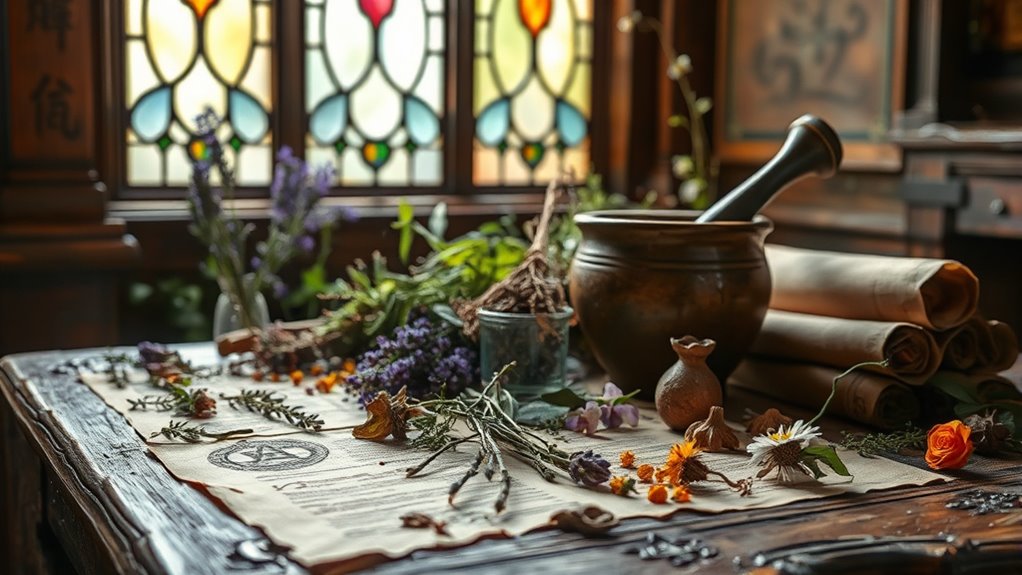
Healing plants played a pivotal role in European witchcraft rituals and spells, serving as both practical remedies and powerful symbolic tools. In witchcraft rituals, you often incorporate herbs to harness their herbal symbolism, believing they amplify your intentions. Spells might involve burning herbs for purification or creating charms with specific plants to attract healing energy. You could also use herbs during moon phases or in potion-making, aligning your ritual with natural energies. Some common practices include:
Healing herbs in spells and rituals amplify intentions, purify energy, and attract health through symbolic and practical use.
- Anointing candles with herbal oils to focus intent
- Creating herbal sachets for protection or health
- Incorporating plants into ritual baths for cleansing
- Using specific herbs in divination or spell casting
These methods highlight the significance of healing plants in traditional witchcraft rituals, blending symbolism with practical application.
The Cultural Significance of Herbal Lore Across Europe
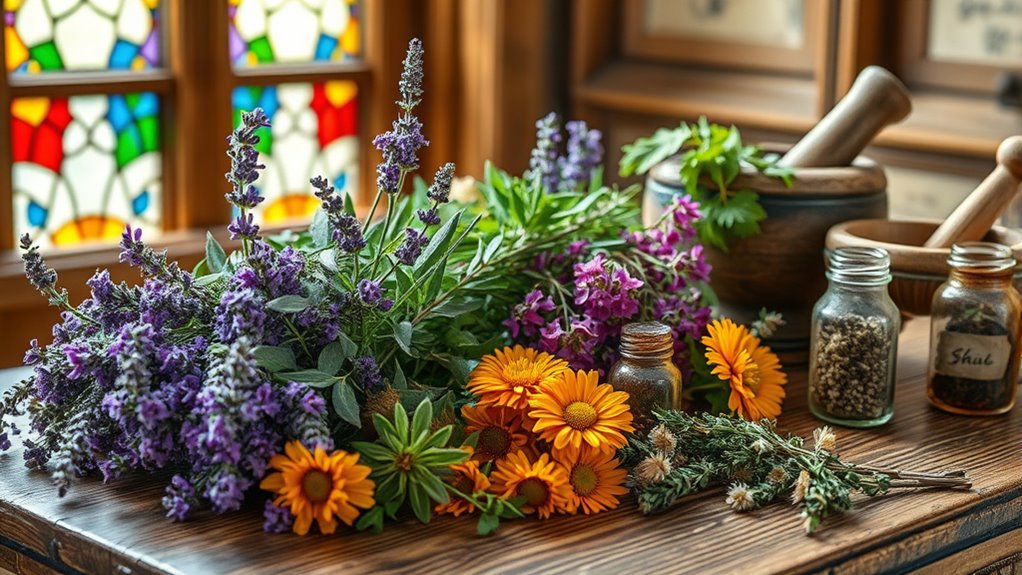
You can see how regional herbal traditions shape local practices and beliefs, creating unique blends of healing and magic. Folklore often uses symbolism to deepen the meaning of herbs, connecting them to cultural stories and values. As you explore, you’ll notice how this knowledge has been preserved and passed down, keeping these traditions alive through generations.
Regional Herbal Traditions
Have you ever wondered how different regions across Europe developed their unique herbal traditions? These variations stem from local climates, resources, and cultural influences. In medieval medicine, herbal remedies played a vital role, with herbal taxonomy helping categorize plants for health uses. Each region’s herbal lore reflects its history and environment, shaping distinct healing practices. For example, Southern Europe favored aromatic herbs, while Northern traditions relied on hardy woodland plants. These regional differences helped preserve unique knowledge passed through generations. By exploring local customs, you can see how herbal remedies became intertwined with cultural identity. Understanding these traditions reveals the rich diversity of European herbal medicine and its enduring significance in folk practices. This regional approach enriches your appreciation of herbal healing’s cultural roots.
Symbolism in Folklore
Across Europe’s diverse herbal traditions, plants often carry more than medicinal value—they embody deep cultural meanings and spiritual beliefs. Medieval symbolism shaped much of this folklore, imbuing herbs with specific powers or moral lessons. For example, the holly’s sharp leaves symbolized protection against evil, while rosemary represented remembrance and fidelity. Folklore motifs frequently linked herbs to mythic stories or spiritual forces, reinforcing their significance beyond healing. These symbols influenced daily life, rituals, and witchcraft practices, reflecting societal values and fears. You can see how each plant’s folklore meaning reinforced its perceived power, blending practical use with spiritual symbolism. This cultural layer reveals how Europeans historically viewed plants as active participants in their spiritual and social worlds.
Preservation of Knowledge
The preservation of herbal knowledge across Europe reflects a rich tapestry of cultural exchange, oral traditions, and written records that have endured through centuries. This herbal preservation guarantees that botanical documentation remains a crucial link to understanding traditional healing practices. Through manuscripts, herbals, and folk stories, you gain insight into how different regions valued and utilized plants. These records not only safeguard practical uses but also carry symbolic meanings tied to local beliefs. By studying these sources, you connect with centuries of herbal lore passed down through generations. The enduring importance of botanical documentation highlights how herbal knowledge shaped cultural identities and medicinal practices. Preserving this knowledge allows you to appreciate the depth of Europe’s herbal heritage and its influence on modern herbalism.
Modern Reinterpretations of Ancient Herbal Practices

Modern reinterpretations of ancient herbal practices breathe new life into traditional European witchcraft, blending age-old wisdom with contemporary insights. Today, people explore medieval medicine, uncovering how herbs were used for healing and spiritual purposes. These practices often relied on herbal symbolism, where each plant represented specific qualities or energies believed to influence health and well-being. Modern herbal enthusiasts adapt these symbolic meanings, integrating scientific research to validate traditional uses. This blending of old and new creates a fresh perspective on herbal healing, emphasizing both cultural significance and practical effectiveness. You might find practitioners combining historical knowledge with modern herbalism, respecting the spiritual aspects while embracing evidence-based methods. These reinterpretations preserve the essence of ancient practices, making them relevant and accessible today.
Frequently Asked Questions
Were Herbs Actually Used for Healing in Medieval European Witchcraft?
You’ll find that herbs were genuinely used for healing in medieval European witchcraft. People relied on medicinal traditions that connected herbal symbolism with health benefits, often blending practical treatment with spiritual meaning. Herbs like mugwort and mandrake played roles in healing rituals, reflecting a deep-seated belief in nature’s power. While some practices were based on folk wisdom, many herbs served as real remedies, blending fact and tradition in their use.
How Accurate Are the Mystical Properties Attributed to Herbs Historically?
You might think the mystical properties of herbs are just fairy tales, but they often reflect deep herbal symbolism and mystical correspondences rooted in tradition. While some attributions are exaggerated or symbolic, many herbs genuinely held spiritual significance, influencing healing practices. Their attributed mystical powers can be seen as a way to connect with nature’s hidden energies, making their historical accuracy both a blend of fact, fiction, and cultural belief.
Did Ancient Europeans Believe Herbs Could Ward off Evil Spirits?
Yes, ancient Europeans believed herbs could ward off evil spirits. They often used herbal amulets and charms for evil warding, placing herbs like vervain and garlic around their homes or wearing them as protection. These practices stemmed from the idea that certain herbs held mystical properties capable of repelling malevolent forces, making them a essential part of their spiritual and daily defenses against evil influences.
Are There Scientific Studies Supporting the Efficacy of Traditional Herbal Remedies?
Sure, scientific validation often supports herbal efficacy, but don’t expect miracles. While some studies show certain herbs can help with ailments, many traditional remedies lack rigorous testing. So, you might find evidence backing some herbal claims, yet skepticism remains. You get to decide if ancient wisdom or modern science holds the key. In the end, it’s a mix of tradition, trial, and a little bit of scientific curiosity.
How Have Modern Interpretations Changed the Understanding of Herbal Magic?
Modern herbal practices have shifted how you see herbal magic, emphasizing scientific research and health benefits. Cultural reinterpretations blend traditional beliefs with contemporary understandings, making herbal magic more accessible and credible today. You might find that herbal remedies are now viewed through a lens of both historical significance and modern science, which enriches their meaning. This evolution helps you appreciate herbal magic as a blend of cultural heritage and evolving health practices.
Conclusion
Remember, the truth often lies beneath the surface, and myths can obscure real wisdom. As you explore the healing herbs of European witchcraft, you’ll see that fact and fiction intertwine like roots beneath the earth. Embrace the knowledge of ancient plants, but stay grounded—what’s truly magic is understanding their power. In the end, the more you learn, the more you realize that old herbs still hold timeless secrets, waiting for you to uncover.

